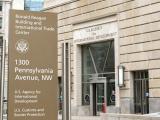Mar 19, 2013
FDA: simple steps curb Salmonella transmission from feeder rodents, reptiles
The US Food and Drug Administration (FDA) yesterday posted tips on preventing Salmonella infections for people who handle feeder rodents as well as reptiles and some amphibians. In a notice it said live and frozen feeder rodents are often fed to certain reptiles and amphibians and that all three animals naturally carry Salmonella in their intestines, which can contaminate the outside of their bodies, their habitats, and surfaces that come into contact with them or their environments. In April 2012 the Centers for Disease Control and Prevention (CDC) linked feeder rodents to an outbreak that sickened at least 46 people in 22 states and said Salmonella may now be endemic in feeder rodents. The FDA said freezing doesn't kill the bacteria, so contamination can persist on frozen rodents. Infections can stem from handling any of these animals, the surfaces they've been in contact
with, or environments in which the animals live. The FDA said people should wash their hands thoroughly after handling the animals, their food, or anything in their habitat. It noted that hand sanitizers can be used if soap and water aren't available.
Mar 18 FDA update
Apr 19, 2012, CIDRAP News scan "Feeder rodents cited in 22-state Salmonella outbreak"
Study estimates total costs of contaminated water supply in Colorado city
A spring 2008 outbreak of Salmonella Typhimurium in Alamosa, Colo. (population 8,746 in 2008), caused by contaminated city water cost a total of $2.6 million in direct economic costs but also cost the health and trust of many residents, say the authors of a study yesterday in PLoS One. The city's water was declared unsafe to drink for about 3 weeks following an outbreak of 432 cases (124 lab-confirmed), 20 hospitalizations, and 1 death. In the current study, the researchers surveyed all Alamosa households receiving water bills from the city as well as businesses in the fall of 2009; they also conducted interviews with governmental and nongovermental agencies, healthcare facilities, and schools to assess the costs and the outbreak's long-term effects on the community. Total costs to residents, using a Monte Carlo simulation model, were $1.5 million, but this number rose to $2.6 million when the
costs to agencies and healthcare facilities for outbreak response were included. The number of people using municipal water as their main source of drinking water fell from 91% (699 of 771) before the outbreak to 30% (233) afterward. The Alamosa outbreak was one of the largest drinking water–associated outbreaks since a large 1993 Cryptosporidium outbreak in Milwaukee.
Mar 18 PLoS One study
TB continues slow decline in European region, amid challenges
The number of tuberculosis (TB) cases in European countries continued to drop in 2011, but officials didn't see a decrease in the number of extrapulmonary TB infections, according to an updat today from the World Health Organization (WHO) Regional Office for Europe and the European Centre for Disease Prevention and Control (ECDC). Countries in the WHO's European region reported 72,000 cases of TB in 2011, a 4% decrease from 2010, according to an ECDC press release. Rates varied across different countries, from 2.8 per 100,000 population in Iceland to 89.7 in Romania. The WHO said in a statement that countries in the Baltic region bear 87% of Europe's TB burden. It noted that multidrug- and extremely drug-resistant TB (MDR-TB and XDR-TB) levels decreased slightly but continued to be prevalent in TB patients from the three Baltic countries. ECDC Director Marc Sprenger, MD, PhD, said in the ECDC release that patients with
extrapulmonary TB are often neglected in TB control strategies, and the agency estimated that one in five TB patients in Europe have that form of the disease, which is rarely infectious but is linked to significant morbidity and long-term complications. The ECDC launched a video documentary to raise awareness about extrapulmonary TB, which can be difficult to diagnose.
Mar 19 ECDC press release
Mar 19 WHO press release
Mar 19 WHO/ECDC TB surveillance
report
ECDC extrapulmonary TB video
Avastin recalled for possible eye infection in off-label use
The FDA yesterday issued a recall of the angiogenesis inhibitor Avastin distributed in sterile unit-dose syringes because of five reported intraocular infections from off-label use of the drug for macular degeneration. Avastin (generic name bevacizumab) was developed as 5-FU–based chemotherapy for metastatic colorectal and kidney cancers, advanced nonsquamous non-small cell lung cancer, and glioblastoma. Some ophthalmologists are using the drug as intravitreal injections to inhibit growth of vascular endothelial growth factor, which stimulates abnormal blood vessel formation in age-related macular degeneration and diabetic retinopathy. The syringes being recalled were distributed to doctors' offices in Georgia, Louisiana, South Carolina, and Indiana starting on Dec 18, 2012. Consumers can call 866-880-1915 or e-mail clinicalrx@bellsouth.net with questions, and any consumer
who has experienced problems that may be related to receiving the drug should contact his or her physician, according to the notice.
Mar 18 FDA recall notice
















